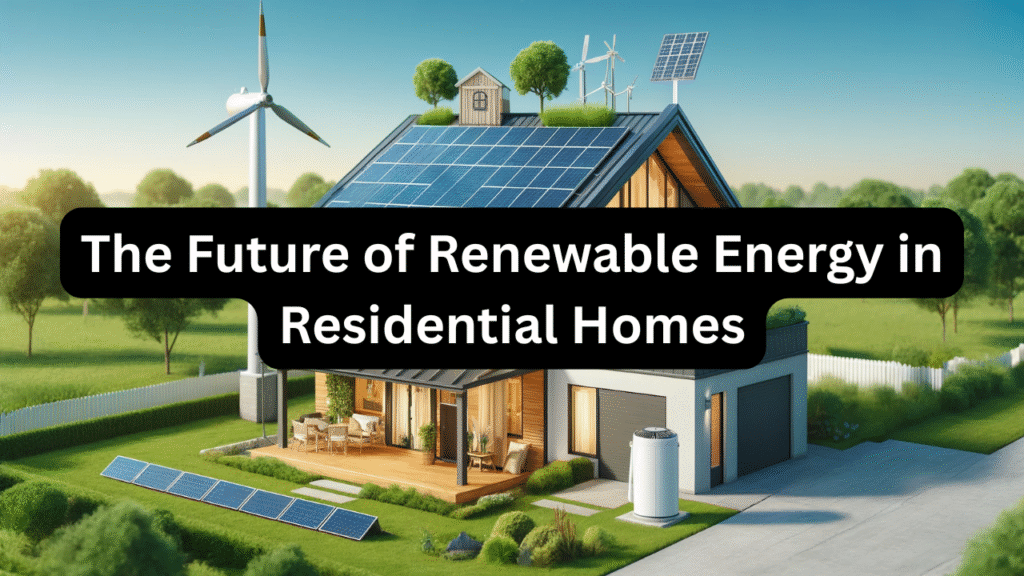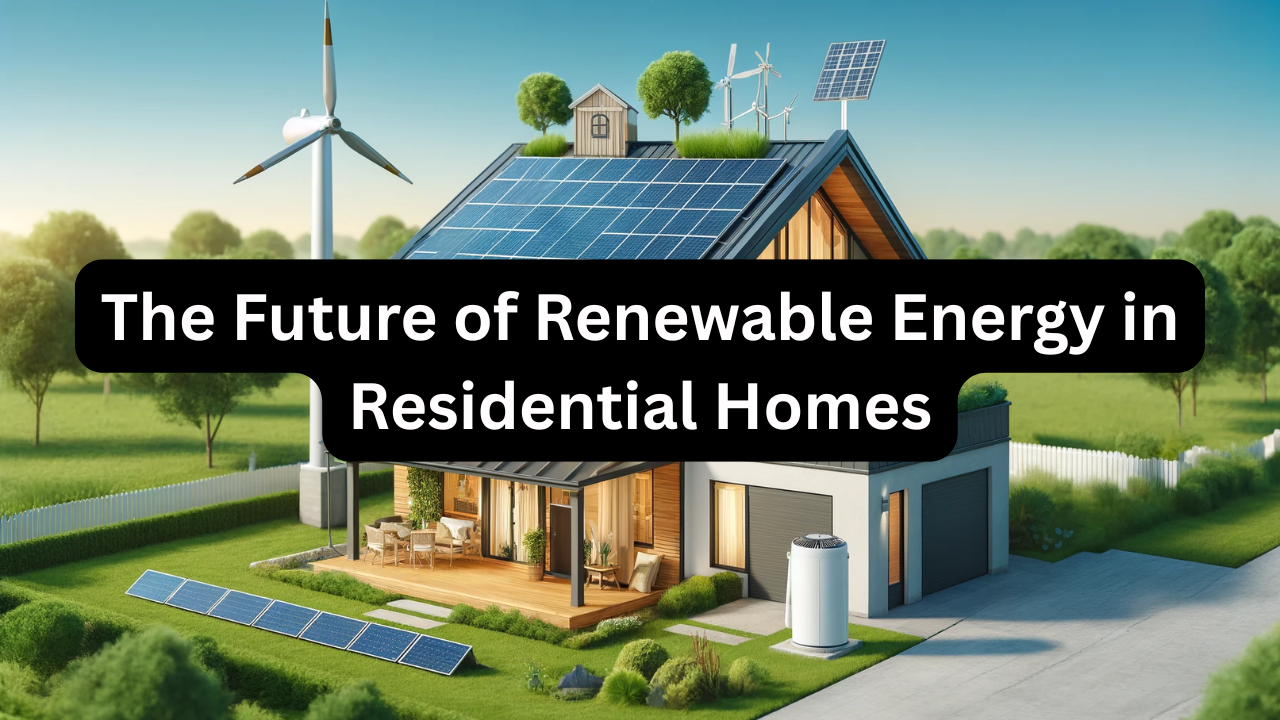
Renewable energy is no longer just a global environmental goal—it’s becoming a household reality. With falling technology costs, government incentives, and increasing environmental awareness, more homeowners are switching to clean energy solutions to power their daily lives. From solar panels to home battery storage and micro wind turbines, the future of residential energy is set to be greener, smarter, and more self-sufficient than ever before.
Why Renewable Energy in Homes Is the Future
Rising energy prices, climate change, and the push for sustainable living are driving a massive shift toward renewable power in residential areas. Modern innovations make it easier for homeowners to generate, store, and manage their own energy, reducing dependency on traditional utility grids.
Key benefits include:
- Lower Energy Bills – Generate your own electricity and cut monthly costs.
- Energy Independence – Less reliance on power companies during outages.
- Eco-Friendly Living – Reduced carbon footprint and cleaner air.
- Long-Term Savings – Systems often pay for themselves within years through energy savings.
Leading Renewable Energy Options for Homes
1. Solar Photovoltaic (PV) Systems
- How It Works: Converts sunlight into electricity.
- Pros: Low maintenance, scalable, works in most climates.
- Cons: Efficiency drops in low sunlight conditions.
2. Solar Water Heating Systems
- How It Works: Uses solar collectors to heat water directly.
- Pros: Reduces water heating costs significantly.
- Cons: Works best in sunny regions.
3. Small-Scale Wind Turbines
- How It Works: Converts wind energy into usable electricity.
- Pros: Great for rural or windy locations.
- Cons: Requires sufficient wind speed to be effective.
4. Home Biomass Heating
- How It Works: Burns organic material like wood pellets for heat.
- Pros: Renewable fuel source, low emissions with modern systems.
- Cons: Requires storage for fuel.
5. Home Battery Storage Systems
- How It Works: Stores excess solar or wind energy for later use.
- Pros: Provides backup power during outages.
- Cons: Initial installation cost can be high.
Comparison Table: Renewable Energy Options
| Technology | Main Function | Best For | Average Cost | Lifespan (Years) |
|---|---|---|---|---|
| Solar PV Panels | Generate electricity | Urban/suburban homes | $8k–$20k | 25–30 |
| Solar Water Heater | Heat water | Sunny climates | $3k–$7k | 15–20 |
| Small Wind Turbine | Generate electricity | Rural/windy areas | $10k–$70k | 20–25 |
| Biomass Heating System | Heat home/water | Rural properties | $5k–$15k | 15–20 |
| Home Battery Storage | Store renewable energy | Homes with solar/wind systems | $5k–$15k | 10–15 |
The Role of Smart Energy Management
Modern renewable systems aren’t just about generation—they’re about efficiency. Smart energy management systems allow homeowners to:
- Track real-time energy production and consumption.
- Automate appliance usage during peak renewable generation hours.
- Sell excess power back to the grid through net metering.
- Optimize battery storage use for backup power.
Government Incentives and Policies
Many countries now offer incentives to make home renewable energy more affordable, including:
- Tax Credits – Offset a percentage of installation costs.
- Rebates – Direct cash savings for adopting clean energy.
- Feed-in Tariffs – Get paid for the renewable energy you export to the grid.
- Zero-Interest Loans – Financing options for green upgrades.
These policies significantly reduce the payback period of renewable systems, encouraging more homeowners to invest.
Challenges Facing Residential Renewable Energy
While promising, the transition comes with obstacles:
- High Upfront Costs – Though decreasing, initial investment can be a barrier.
- Space Requirements – Solar panels and wind turbines require adequate installation space.
- Variable Energy Production – Weather conditions affect output.
- Maintenance Needs – Systems require periodic servicing to maintain efficiency.
Overview Table
| Technology/Trend | Main Advantage | Current Adoption Level | Future Potential | Ideal Use Case | Cost Trend |
|---|---|---|---|---|---|
| Solar PV Panels | Low-cost electricity | High | Very High | Most climates with roof space | Decreasing |
| Battery Storage | Energy independence | Medium | Very High | Backup during outages | Decreasing |
| Home Wind Turbines | Rural power generation | Low | Medium | Windy, rural areas | Stable |
| Solar Water Heating | Lower heating costs | Medium | High | Homes with high hot water usage | Decreasing |
| Biomass Heating | Renewable heating | Low | Medium | Off-grid or rural heating | Stable |
| Smart Energy Management | Optimize energy use | Medium | Very High | Any home with renewable systems | Decreasing |
The Next Generation of Renewable Home Technology
- Building-Integrated Photovoltaics (BIPV): Solar panels built into windows, roofs, and walls.
- Vehicle-to-Home (V2H) Power: Electric vehicles supplying power back to the home during outages.
- AI Energy Prediction: Artificial intelligence optimizing when and how energy is stored or used.
- Microgrids for Communities: Shared renewable power systems across neighborhoods.
Conclusion
The future of renewable energy in residential homes is moving toward total self-sufficiency. With rapidly improving technology, falling costs, and strong government incentives, every household has the opportunity to become its own power plant. Whether through solar panels, wind turbines, biomass heating, or smart storage, the shift to renewables will redefine how we live, save money, and protect the planet.
Homeowners who embrace this transition now will not only enjoy immediate benefits but will also future-proof their properties against rising energy prices and environmental challenges.
3 One-Line FAQs
Q1: Which renewable energy option is most popular for homes?
A1: Solar photovoltaic panels remain the top choice due to affordability and ease of installation.
Q2: How long does it take for solar panels to pay for themselves?
A2: Most solar systems recoup their cost within 5–8 years, depending on location and incentives.
Q3: Can renewable energy make my home completely off-grid?
A3: Yes, with the right combination of generation, storage, and efficiency systems, full independence is possible.

